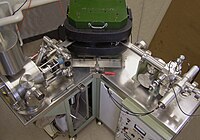Isotope-ratio mass spectrometry

Okay kiddo, have you ever heard of atoms? They are the building blocks of everything around us. Atoms are made up of even smaller parts called protons, neutrons, and electrons.
Well, some atoms have different numbers of neutrons in their centers. For example, the hydrogen atom usually has only one proton and one neutron, but sometimes it can have one proton and two neutrons. We call these different forms of the same atom isotopes.
Now, scientists want to study these isotopes to learn more about things like the environment, climate change, and even how our bodies work. This is where isotope-ratio mass spectrometry comes in.
It’s kind of like a special machine that can tell the difference between the different isotopes of an element. Here's how it works:
First, scientists take a tiny sample of the material they want to study, like a piece of hair or soil. They put the sample into the machine and heat it up until it turns into a gas.
Once the sample is in gas form, it gets shot with a beam of electrically charged particles called ions. These particles knock off electrons from the gas atoms and create even smaller particles called ions.
Next, the ions get passed through a special machine that separates them based on their mass. The bigger ions go one way, and the smaller ions go another way.
Finally, the machine counts the number of each type of ion and calculates the ratio of different isotopes in the original sample.
So, to sum it up, isotope-ratio mass spectrometry is a fancy way of measuring different types of atoms in a sample. This helps scientists learn more about the things around us and how they work!
Well, some atoms have different numbers of neutrons in their centers. For example, the hydrogen atom usually has only one proton and one neutron, but sometimes it can have one proton and two neutrons. We call these different forms of the same atom isotopes.
Now, scientists want to study these isotopes to learn more about things like the environment, climate change, and even how our bodies work. This is where isotope-ratio mass spectrometry comes in.
It’s kind of like a special machine that can tell the difference between the different isotopes of an element. Here's how it works:
First, scientists take a tiny sample of the material they want to study, like a piece of hair or soil. They put the sample into the machine and heat it up until it turns into a gas.
Once the sample is in gas form, it gets shot with a beam of electrically charged particles called ions. These particles knock off electrons from the gas atoms and create even smaller particles called ions.
Next, the ions get passed through a special machine that separates them based on their mass. The bigger ions go one way, and the smaller ions go another way.
Finally, the machine counts the number of each type of ion and calculates the ratio of different isotopes in the original sample.
So, to sum it up, isotope-ratio mass spectrometry is a fancy way of measuring different types of atoms in a sample. This helps scientists learn more about the things around us and how they work!
Related topics others have asked about:
